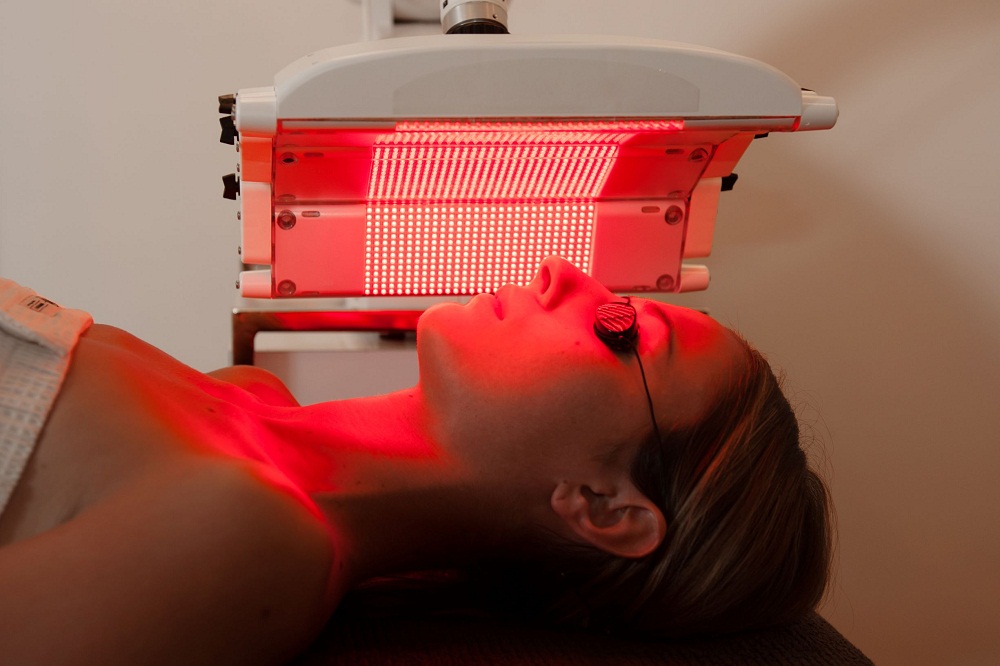Are you interested in whether near-infrared light can cause damage to the eyes or does it have a beneficial effect?
Red light therapy has been on the market for many years now, and unlike others, it has proven highly beneficial from day one. But we still have to talk about how it affects the eyes.
The therapy is safe and all-natural, making it possible to give it as a complementary treatment for various medical ailments, including arthritis, stiff joints, and muscle discomfort, to mention a few.
Is near infrared light safe for eyes? Let’s begin with the article to learn more about infrared lights in general.

Source: holistic4spirit.com
What Are Near Infrared Lights?
Near-infrared lighting consists of low-frequency radiation next to red colors in the visible spectrum. Contrary to popular belief, including that of some professionals, the brightness we observe in near-infrared lights is caused by reflected sunshine rather than warmth.
Rock brightness is higher in near-infrared photographic products, while air scattering has less of an impact on longer wavelengths.
The near-infrared sensitivity to vegetation type, density, water content, and general plant health, however, is its main benefit.
However, colors on color near-infrared images do not have the same significance as colors on visible region photographs.
Generally speaking, near-infrared light is defined as having a wavelength between 800 and 2,500 nanometers. Like mid-infrared light, near-infrared light absorption depends on the material’s vibration.
Since near-infrared light absorption is dependent on overtones and blended tones in the mid-infrared light spectrum, it is substantially less in strength when compared to mid-infrared light absorption.
How Does Infrared Light Therapy Work
Deeper layers of the skin can be reached by infrared light, which can travel a distance of between two and seven centimeters. Consequently, it penetrates the bones, nerves, and muscles.
Electric eels were employed to deliver electric shocks about 2,750 BC, marking the beginning of the usage of electricity for therapeutic purposes. With only little success, electricity and magnetism were utilized on individuals.
Transcutaneous electrical stimulation, or TENS, was created to relieve chronic pain in 1975. It took some time for infrared therapy to be created to speed up wound healing, lessen arthritis pain, increase endorphin levels, and bioactivate neuromodulators.
Without being exposed to dangerous UV rays, infrared therapy technology enables patients to reap the benefits of the sun.
In addition, there are no harmful side effects associated with infrared therapy. Infrared light is considered safe and is employed even for newborns in neonatal intensive care.
What Sets It Apart from Conventional LED Light Therapy?
Blue and red LED light treatment is well known for its capacity to superficially renew the skin.
By penetrating deeper into the skin and tissue, near-infrared advances the process and enables clinicians to address brittle skin support structures that cause aging symptoms, including wrinkles, thin, lax skin, and coarse skin.
The production of new collagen and elastin proteins, which are essential for preserving firm, smooth, supple, and wrinkle-free skin, is stimulated by near-infrared light.
Is Near Infrared Light Safe for Eyes?
In a nutshell, yes is the correct response to this question. Near-infrared light therapy, which may protect and heal your eyes, has become a safe and all-natural treatment option thanks to scientific research and technological development.
Near-infrared light has been proven to be safe and beneficial for maintaining eye health in numerous studies. But to ensure yourself, you can try some of the best eye protection for light therapy.
Surprisingly, near-infrared light may treat a wide range of conditions and diseases, such as glaucoma, age-related macular degeneration, and eye injuries.
An estimated 200 million people worldwide suffer from age-related macular degeneration. It results from a reduction in ATP synthesis in the cells of the eye.
Adenosine triphosphate within the mitochondria of the cell is naturally stimulated by near-infrared light therapy. The body can regenerate, repairing damaged cells and generating new, young ones when the cells produce more ATP.
The eyes can be treated for diseases and ailments throughout the body by rejuvenating the cells.
Is It Possible to Combine Red and Infrared Light Therapy?
Yes, red and infrared lights can be used together, and in most situations, they should. When utilized together, these two kinds of lighting are powerful.
Anti-aging light therapy devices are one example, with the most successful options almost invariably combining red and infrared lights.
Red LED-only wrinkle reduction devices are less efficient at reducing aging symptoms or enhancing the texture and tone of the skin.
Additionally, the majority of light therapy devices for pain management are made with a mix of red and infrared lights.
How Do the Wavelengths Differ
In many ways, red, near-infrared, and IR wavelengths may offer similar health advantages, such as pain alleviation, and some unexpected advantages, like weight loss.
Although similar, red light and near-infrared differ from one another in how deeply the light photons can penetrate the tissues of your body.
In that it doesn’t heat the body, as is the case with wavelengths in the mid-to-far-infrared light spectrum, NIR light is similar to red light in this regard.
Red light therapy devices use NIR waves up to 850 nanometers. The two most popular uses of IR radiation are in infrared saunas and medical applications.
Why Do Near-Infrared LEDs Appear Non-Functional?
The naked eye cannot see near infrared light. The usual configuration of red light at 660 nanometers and near-infrared light at 850 nanometers is mainly present in all the products.
Near-infrared LEDs ought to function if your red light LEDs do. You may test your equipment by turning off your red light but leaving the NIR light on. The NIR LEDs should be illuminating very subtly.

Source: getthegloss.com
Read more: How Do Infrared Saunas Work
Conclusion
A potent and effective way to mediate biological processes using low-power light wavelengths from the red to near-infrared ranges is near infrared lights, often known as PBM. Cytochrome c oxidase provides energy for metabolic processes in the eyes and neurons.
In cases of methanol intoxication, optic nerve damage and neuropathy, retinal injuries and pigments, and macular degeneration, NIR light can enter these tissues and aid in the recovery of neurons.
So is near infrared light safe for the eyes? Yes, it is, and you can use it to cure a variety of different bodily conditions. But before deciding to do anything, make sure to consult with your doctor.

Hello! I’m Nicky Rodgers.
Almost a decade ago, I got excited about the idea of employing alternative methods like red light therapy to create a healthier life.
To learn more about it, I did my Certified Light Therapist course from Photonic Therapy Institute and started looking into the intricacies of how light therapy influences several bodily processes. Before I knew it, my interest had become an obsession which resulted in this extensive blog.
Here, I offer countless well-researched articles to help you understand the benefits and uses of light therapy. I hope this information gives you a head start in your wellness journey.
